Ipswich Town last played in the Premier League during the 2001/02 season, finishing 18th and being relegated to the second tier.
Now, under manager Kieran McKenna, they’re back in the Premier League for the 2024/25 season, fighting to maintain their place in England’s top flight.
Similar to when Nottingham Forest got promoted a few years ago, Ipswich made a significant number of signings this year to boost their chances of survival.
Their transfers include a mix of young players with potential and experienced individuals capable of making an immediate impact, similar to Nottingham Forest’s approach when they signed 20 players upon their Premier League return.
In this Ipswich Town tactical analysis, we’ll explore some of Ipswich’s most crucial signings, key players brought in to help the team navigate the relegation battle, and some fundamental tactics they’ve been using.
Currently, Ipswich sit 17th in the table with eight points from 11 matches, just one point clear of Crystal Palace.
This leaves them narrowly above the relegation zone.
Through key data and tactical insights, we aim to provide a transparent overview of Ipswich’s season so far.
Their fight for survival looks to continue throughout the rest of the season.
Ipswich Town Transfer Arrivals – 2024/25
Ipswich Town made significant moves in the 2024/25 transfer window, spending €126.49m to strengthen their squad.
Ipswich Town Defensive Signings
Ipswich addressed their goalkeeping needs by signing Arijanet Muric, a 25-year-old goalkeeper from Burnley, for €9.55m.
For the backline, they brought in players capable of starting immediately and others to add depth across multiple roles.
We start with Jacob Greaves, a 23-year-old centre-back from Hull City who signed for €21.5m, and Dara O’Shea, a 25-year-old centre-back from Burnley, who was signed for €14.2m.
At wingback, Conor Townsend, a 31-year-old left-back from West Brom, was bought for €590k alongside Ben Johnson, a versatile 24-year-old right-back from West Ham who came on free.Ipswich Town Midfield Signings
Ipswich made their most notable additions in midfield, including players with international experience.
Sammie Szmodics is a 28-year-old attacking midfielder signed up from Blackburn Rovers for €10.6m.
Jens Cajuste is a 25-year-old defensive midfielder from Napoli who arrived on loan for a fee of €1.5m.
The most high-profile signing in midfield was Kalvin Phillips, who is on loan from Manchester City.
Ipswich Town Attacking Signings
In the attack, Ipswich brought in a few names.
One is Jack Clarke, a 23-year-old left winger from Sunderland who was bought for €17.7m.
Liam Delap, a sought-after young talent, is a 21-year-old centre-forward from Manchester City U21 who joined for €17.85m.
Omari Hutchinson is a talented 20-year-old right winger from Chelsea and has become Ipswich’s most expensive signing at €23.5m.
Chiedozie Ogbene is a 27-year-old right winger from Luton Town who was signed for €9.5m.
Ipswich Town Defensive Tactics
Despite Ipswich Town’s investments in their defence and midfield during the 2024/25 transfer window, such as the transfer of experienced players like Kalvin Phillips, the team has conceded 22 goals so far this season, which is tied for the third-most in the Premier League.
Under Kieran McKenna’s tactics, their defensive vulnerability is not unexpected for a newly promoted side.
Still, it needs to be addressed and fixed quickly if they want to stay up in the league this year.
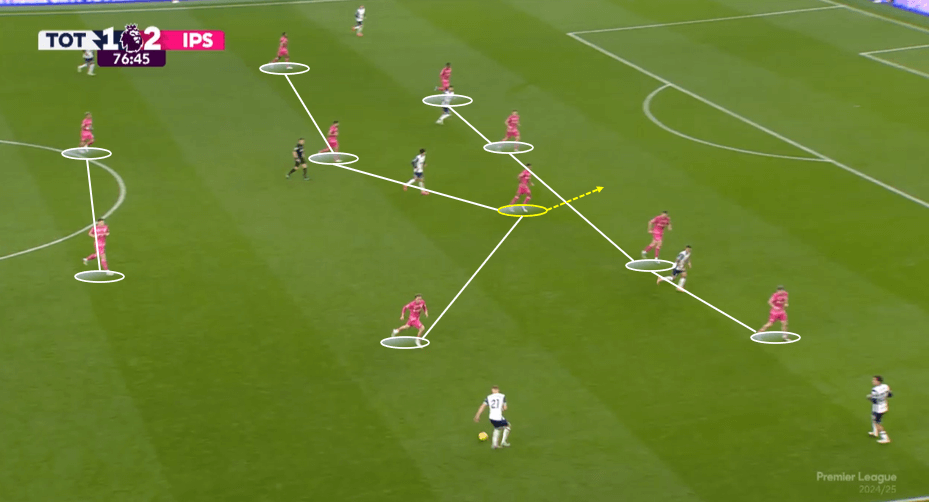
Ipswich Town typically adopts a traditional 4-4-2 formation, a straightforward and defensive setup that suits a team newly promoted to the Premier League.
This formation is very simplistic, which makes sense for a squad integrating numerous new players and focusing on survival rather than implementing complex tactics.
Their 4-4-2 is compact and laid-back, so they can try to minimise gaps centrally and in wide areas.
One of the midfielders, usually occupying the 6/8 role, often sits back deeper, allowing the team to shift into a 5-3-2 formation when needed.
This adjustment provides more defensive stability by positioning the midfielder between the centre-backs.
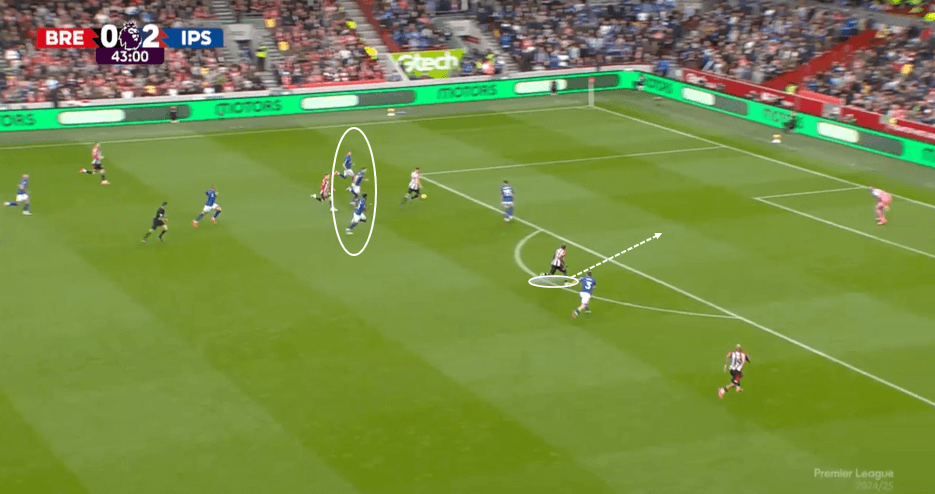
Ipswich Town excel at playing in their low-to-mid defensive block.
However, their major defensive issues arise during transitions when they lack zonal marking, positional play, and coordination, which leaves them vulnerable.
In transition, Ipswich’s players frequently find themselves out of position, creating exploitable gaps that opponents capitalise on.
A clear example of this came in their match against Brentford.
In one sequence, three Ipswich players, circled in white, were seen chasing a single Brentford player towards the ball.
Meanwhile, another Brentford attacker made a deep run into the box, receiving the ball for an easy tap-in.
Neither of Ipswich’s centre-backs could anticipate or intercept this movement, which is an excellent example of their failure to organise defensively during quick transitions.
This lack of coordination during transitional moments has been Ipswich’s most significant defensive weakness this season.
Ipswich Town Attacking Play
Ipswich Town scored 12 goals in their first 11 matches of the season, which tied them for the fourth-fewest alongside Manchester United.
While this is not unusual for a team battling relegation, Ipswich does have some interesting attacking tactics worth analysing under Kieran McKenna’s style of play.
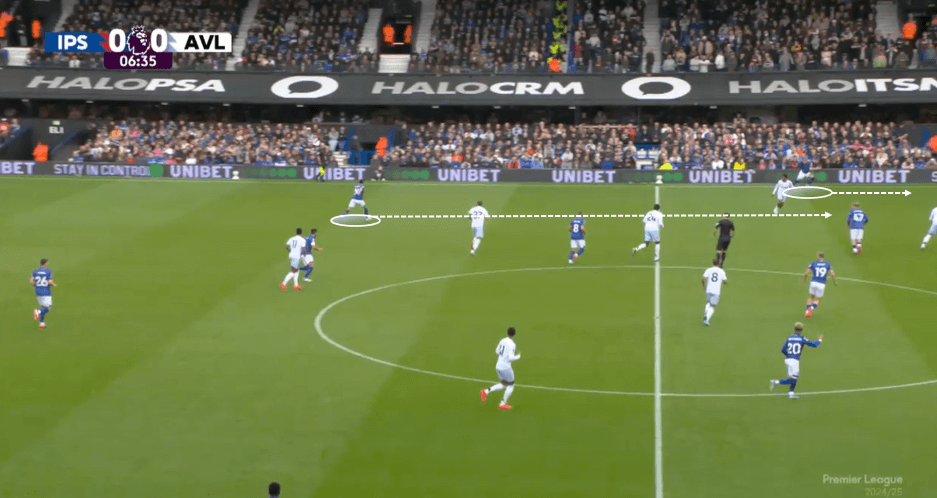
Ipswich like to play through their wingers in attacking transitions.
As seen in the image above, they often go long and direct to their wingers, either into space or at their feet.
In the example, the midfielder skips all passing options to play directly to the winger, a tactic Ipswich frequently use to advance into the final third.

This season, Omari Hutchinson has been extremely important for the club in their attacking play.
They often rely on his wing play to progress the ball forward during transitions.
As shown in the image above, Hutchinson’s dribbling ability and composure in tight spaces make him important.
In the match against Manchester City, he was the reason for their first goal.
He collected the ball from midfield, drove forward into space, and helped create a goal-scoring opportunity.
He has been tasked with this all season: picking up the ball in midfield and helping the transition to the final third.
Ipswich Town Key Statistics
Below, we will examine some key Ipswich Town statistics, including their shot map, shot against map, penetrating carries map, and high regain/pressing statistics.
Ipswich Town Shot Map – 2024/25
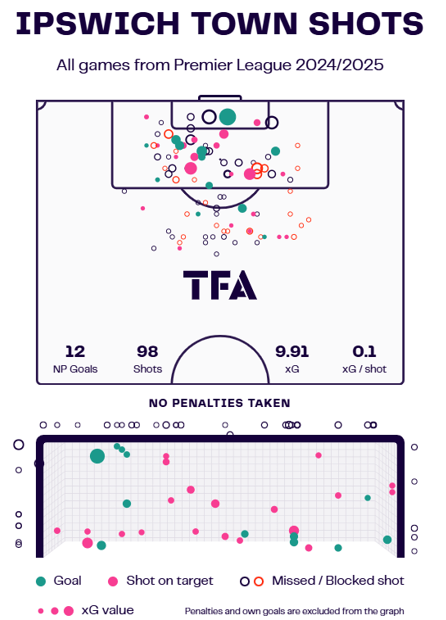
Ipswich’s shot map shows they have an expected goals xG of 9.91 but have scored 12 goals, meaning they are slightly overperforming their xG.
While this efficiency is positive, the concern lies in their low xG generation over 11 matches, which raises questions about their ability to create quality scoring chances consistently.
Ipswich Town Shot Against Map – 2024/25
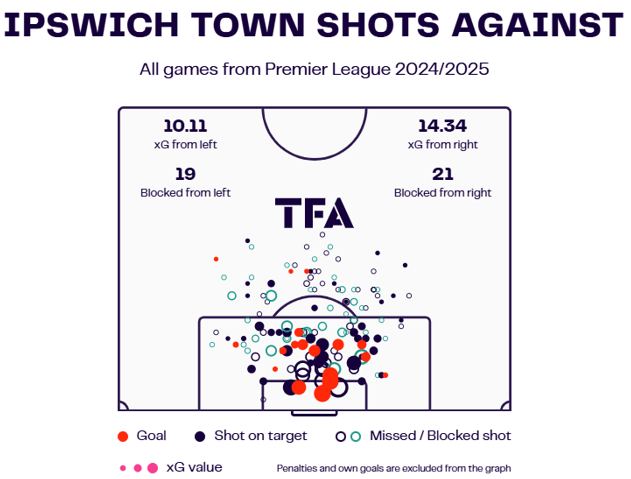
On the defensive side, their shot-against map reveals troubling statistics.
They have faced an xG of 14.34 from the right and 10.11 from the left, combining for a total expected goals against of 24.45.
This suggests they are conceding opportunities that predict an average of at least two goals against them per match.
If this trend continues, it could become a significant problem, as conceding substantially more goals than they can generate on the other end will destroy their chances of survival in the Premier League.
Ipswich Town High Regains Map – 2024/25
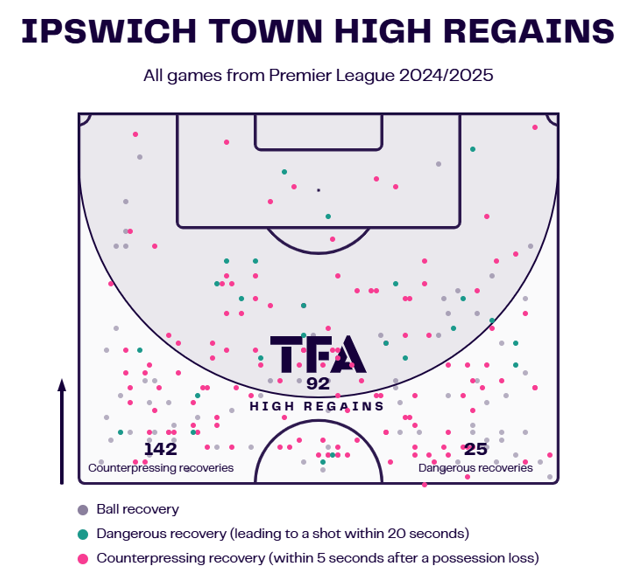
Ipswich Town’s high regain map for the 2024/25 Premier League season showcases their ability to regain possession in advanced areas.
The team has made 92 high regains, 142 counter-pressing recoveries (within five seconds of losing possession), and 25 dangerous recoveries that led to a shot within 20 seconds.
The high importance placed on this high-intensity press could be part of the reason why Ipswich struggles to defend transitions effectively.
Their players often tire out or find themselves out of position due to efforts to win the ball back in the final third or middle part of the pitch.
This leaves the players behind them overwhelmed and unable to cover the gaps left exposed, making Ipswich vulnerable to quick counterattacks.
Ipswich Town Penetrating Carries Map – 2024/25
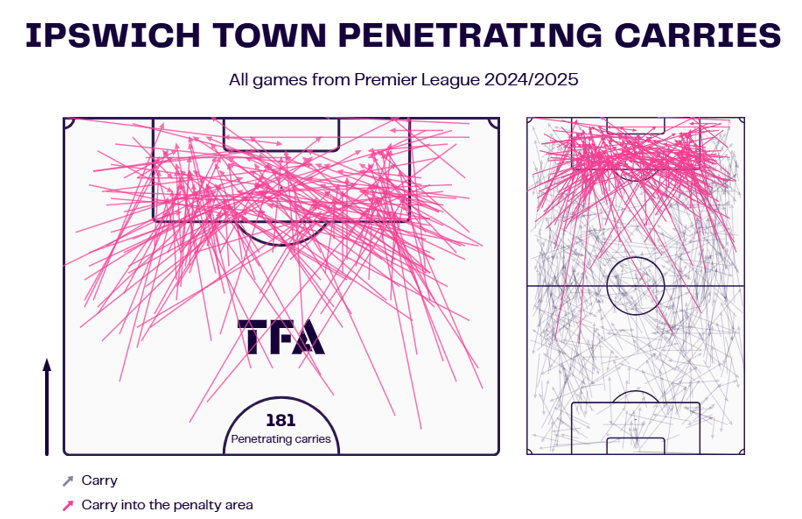
Their penetration carries of 181 over 11 matches is impressive, averaging approximately 16.45 per match. This statistic indicates that Ipswich effectively advances the ball into promising attacking areas.
However, their struggle lies in capitalising on these opportunities and converting them into goal-scoring situations.
This weakness can be attributed to a lack of individual quality in the final third, which is understandable for a newly promoted team adjusting to the challenges of the Premier League.
Conclusion
Overall, Ipswich Town’s season has the potential to see them finish outside the relegation zone.
With some key summer signings, they have brought in quality players who can help keep them up.
However, their main issue lies in defending during transitions, which is causing them to concede a significant number of goals.
If they can eliminate these transitional mistakes, they can stay in the Premier League this year.
Currently sitting 17th, their position is far from secure, and it will be a long season ahead.





Comments